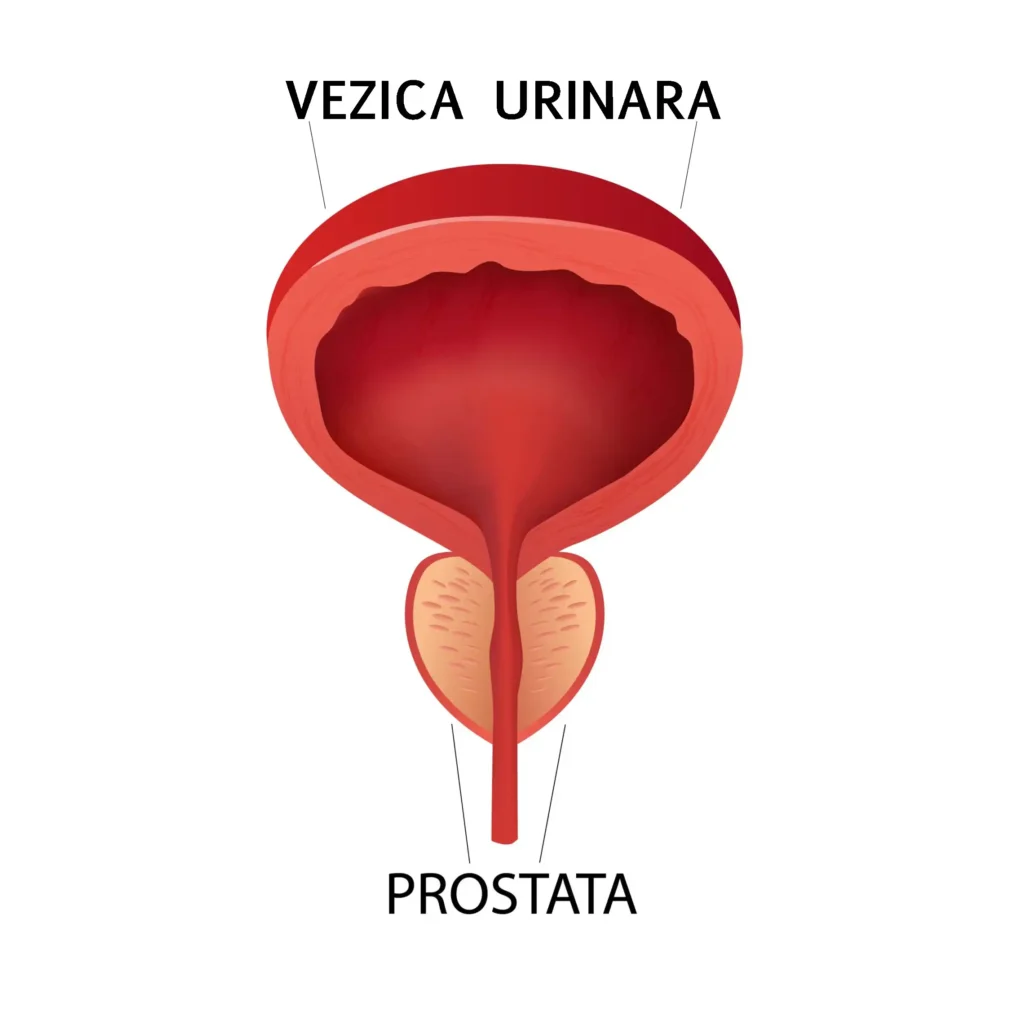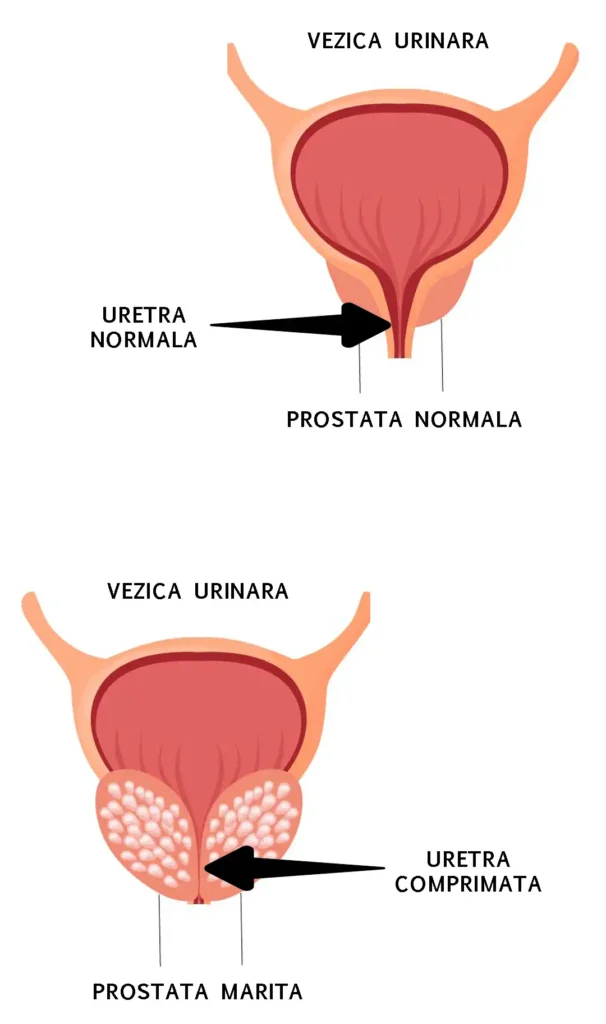
Medical Clinic
We use state-of-the-art medical equipment to ensure effective and safe treatments.
Prostate Adenoma
Prostate adenoma is the most common benign tumor in men over the age of 55, with 70% of men suffering from this condition.
What is the Prostate?

The prostate is an exocrine gland specific to men, located below the bladder, surrounding the upper part of the urethra. Its main role is to secrete an alkaline fluid that forms an important part of the seminal fluid, contributing to the survival and mobility of sperm cells.
Main Functions:
- Production of Prostatic Fluid: The prostate secretes an alkaline fluid that makes up approximately 30% of the total volume of semen. This fluid protects and nourishes sperm, facilitating their mobility and survival in the acidic environment of the female reproductive tract.
- Contribution to Fertility: Prostatic fluid contains essential enzymes and proteins that maintain the fluidity of semen and optimize conditions for fertilization.
- Regulation of urinary flow: By surrounding the urethra, the prostate also plays a role in controlling urinary flow. Prostate conditions can lead to compression of the urethra as it passes through the prostatic urethra, causing difficulties in urination.
What is Prostate Adenoma?

Prostate adenoma is the enlargement of the gland due to the proliferation of glandular tissue, a phenomenon that generally occurs after the age of 50, with the frequency of this condition increasing with advancing age. The enlargement of the prostate (its hypertrophy) takes place under hormonal influence, as prostatic tissue becomes more sensitive to the action of testosterone after a certain age. Prostate adenoma is a slowly progressing condition, developing over several years, with the changes it induces on the urinary system appearing insidiously.
Prostate enlargement (development of prostate adenoma) gradually compresses the urethral caliber, causing changes in both urinary and reproductive function. For proper emptying of the bladder, when the prostate adenoma obstructs the normal elimination of urine, the bladder muscles and abdominal muscles attempt to overcome this obstacle through additional effort, so that initially the urinary stream and flow are not affected. Later, even if these muscles contract more strongly, this mechanism becomes insufficient, leading to the so-called “battle bladder,” in which the bladder walls become hypertrophied and thickened. The incomplete emptying of the bladder explains the appearance of “residual urine,” meaning the remaining amount of urine left inside the bladder after urination, this phenomenon being responsible for the complications of prostate ade
The increase in prostate size in prostate adenoma means that, from a volume of 15–25 cm³ in a young or middle-aged man, the prostate can reach 40, 50, or even 100 cm³ (sometimes more).
The risk factors implicated in the development of prostate adenoma are: genetic factors, age, alcohol consumption, smoking, high blood pressure, obesity and diabetes mellitus, as well as the use of certain medications (antidepressants, antihistamines).
Symptoms & Diagnosis
An enlarged prostate does not always cause symptoms.
The severity of symptoms does not correlate with the size of the prostate.
There are two main categories of symptoms of an enlarged prostate:
OBSTRUCTIVE SYMPTOMS
Difficulty in initiating urination, weak urine stream, intermittent or interrupted stream, difficult urination, prolonged bladder emptying time, feeling of incomplete bladder emptying, loss of urinary control, feeling of incomplete bladder emptying, urinary retention (“urine blockage”).
IRRITATIVE SYMPTOMS
Increased frequency of urination (pollakiuria), especially at night (nocturia), urgency (the sudden and compelling urge to urinate), urge incontinence (the man 'leaks' a few drops before reaching the toilet).
DIAGNOSIS
The diagnosis of prostate adenoma and its possible complications is made only by a specialist urologist, following a clinical examination and the paraclinical investigations recommended by the doctor and performed by the patient.
Investigations for Prostate Adenoma
1. Detailed medical history
The urologist will ask you about your medical history, especially your urological history: the symptoms you are experiencing, their severity, and how they affect your daily life. You will also be asked about the quality of your erections, since poor erections can be caused by obstructive prostate symptoms. Some medications may affect bladder function, and it is important for the doctor to rule out those medications. In younger men (under 45 years), symptoms similar to those caused by prostate obstruction are often due to conditions such as urethral stricture (narrowing of the urethra) or prostate inflammation (acute or chronic prostatitis). The urologist will therefore ask about any history of trauma, conditions, or surgeries involving the urethra that may lead to the development of strictures.
2. Physical examination
You will undergo a complete physical examination, including blood pressure measurement. The doctor will perform a digital rectal examination to assess the size and consistency of the prostate. Abdominal examination may also be useful to reveal a possible enlargement of the bladder.
3. Laboratory tests
- Complete blood count, renal function tests (blood urea and creatinine)
- PSA level – usually measured from the blood of men with obstructive symptoms; if the PSA level is higher than normal or if the prostate appears altered on digital rectal examination, the urologist will recommend additional tests to rule out prostate cancer. An elevated PSA level does not mean the presence of prostate cancer. 50–60% of men with prostatic hypertrophy have increased PSA levels. The only way to rule out prostate cancer is a consultation with a urologist to recommend further investigations;
- Urinalysis – a urine sample will be sent to the laboratory to rule out a possible urinary tract infection.
4. Other specific tests
An abdominal X-ray may be indicated, as well as an abdominal ultrasound to evaluate prostate volume and post-void residual urine, and uroflowmetry (assessment of urinary stream pressure).
www.ro-boost.ro
™ Toate drepturile rezervate.
Address: Bucuresti, strada Dr. Leonte Anastasievici nr. 34, sector 5
Phone: 0743.153.954 | 0743.153.960
Email: contact@ro-boost.ro